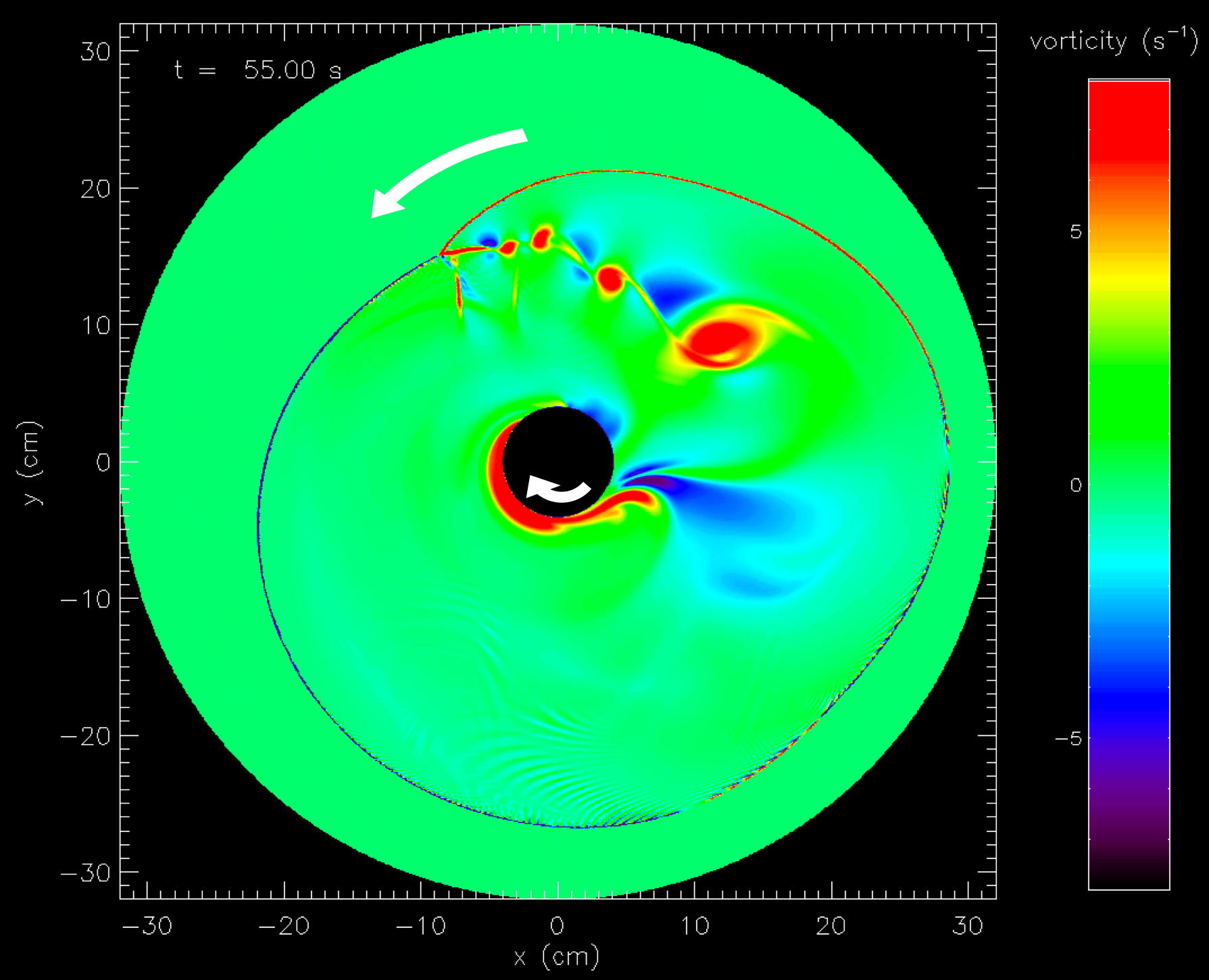The explosive death of massive stars begins with the collapse of their iron core which gives birth to a neutron star. Despite spherical initial conditions, this explosion can kick the neutron star several hundred kilometers per second. Exclusively studied by numerical simulations so far, the hydrodynamic instability responsible for this asymmetry is revealed here in a simple experiment. Making use of the analogy between surface waves in water and shocks in a compressible gas, it describes the mechanism contributing to the neutron star kick and spin at birth. The work led by Thierry Foglizzo at the Astrophysical Department - AIM laboratory (CEA/Irfu - CNRS - University Paris Diderot) and co-workers is an original combination of theory, numerical simulations and experimental analogy addressing a complex astrophysical phenomenon. These results are published in Physical Review Letters, February 3, 2012.
|
Along a surface shaped like a gravitational well, the axisymmetric inflow of water turns into an oscillatory motion. On a scale a million times larger and a hundred times faster, the same phenomenon leads to the ejection of a neutron star during a supernova explosion. (Credit CEA-SN2NS). |
The SWASI experiment, from acoustic to surface waves.
The experiment called SWASI for "Shallow Water Analogue of a Shock Instability" is a hydraulic analogue of SASI [1], based on the analogy between acoustic waves in a gas and surface gravity waves in water. During stellar core collapse, acoustic waves and vortices located between the neutron star and the stationary shock are coupled according to a mechanism discovered at CEA/SAp in 2002. In the SWASI experiment, surface gravity waves and vortices interact in the same manner between the central accretor and the stationary hydraulic jump.

The gas falling towards the center of the star is analogue to water flowing along a potential-like surface. The shock wave produced by the gas hitting the neutron star surface is replaced in the experiment by a hydraulic jump, similar to the classical kitchen sink experiment (left). The hydraulic jump separates the region where the fluid flows faster than surface waves, from one where the flow is deeper and slower. In the experiment (middle diagram), water is injected through a slit from an annular reservoir (R), and spills over the edge of the central vertical pipe (C). A pump (P) establishes a closed circuit. The hydraulic jump is initially circular (right). It becomes unstable when the flow rate exceeds a threshold (above video).
The hydraulic jump is 20 cm in radius and oscillates with a period of about 3 seconds. In a collapsing star, the shock radius extends to 200 km with an oscillation period of 30 milliseconds. The SWASI experiment is thus a million times smaller and 100 times slower than its astrophysical analogue.
Numerical simulations and experiments as two complementary tools
The team of researchers used numerical simulations to check that a 2D model of the experiment can account for the oscillation period. Using both the experiment and numerical simulations allows them to overcome the limitations inherent to each tool and to validate the physical nature of the observed phenomena. In particular, the experiment confirms the potential effect of the instability on the spin of neutron stars. Even though the fluid is injected without rotation into the experiment, the development of the instability is able to induce a global rotation of the hydraulic jump in one direction, while the internal regions rotate in the opposite direction.
 |
 |
|
Comparison between the experiment (left) and the 2D numerical simulation (right). The hydraulic jump rotates in one direction while the inner fluid rotates in the opposite direction, as revealed by the rotation of the horizontal bar. Both movements are also observed in the numerical simulation, where the color scale indicates the strength of vorticity. (Credit CEA, movies available on the SN2NS page). |
SWASI, a scientific and pedagogical experiment
The SWASI experiment establishes an unexpected parallel between the familiar hydraulic jump observed in a kitchen sink and the gas dynamics governing the birth of both a neutron star and a supernova. Experimental results confirm that the aspherical character of the explosion is a robust outcome of fluid mechanics. Easy to use, this new research tool will be modified to incorporate the effects of stellar rotation. The simplicity of the setup allows for an intuitive and pedagogical approach of complex astrophysical phenomena.
Contact :
"A Shallow Water Analogue of the Standing Accretion Shock Instability: Experimental Demonstration and Two-Dimensional Model"
T. Foglizzo, F. Masset, J. Guilet, G. Durand
published in Physical Review Letters, February 3, 2012.
electronic pdf version, Astro-ph, pdf file (320 Ko)
Read also the Viewpoint: "Seeing Stellar Explosions with Shallow Water"
See also : SN2NS web page (SuperNova to Neutron Stars) : movies of the experiment and numerical simulations are available on the page "Outreach"
Notes :
[1] The instability named SASI pour Stationary Accretion Shock Instability for Stationary Accretion Shock Instability plays a central role during the last second before the supernova explosion: transverse motions lengthen the accretion time of the infalling gas, resulting in a longer exposure to the neutrino flux. If these neutrinos deposit sufficient energy to reverse the collapse into an outward motion, the SASI-induced deformations produce an asymmetric explosion.
Written by : Thierry Foglizzo, Christian Gouiffès



